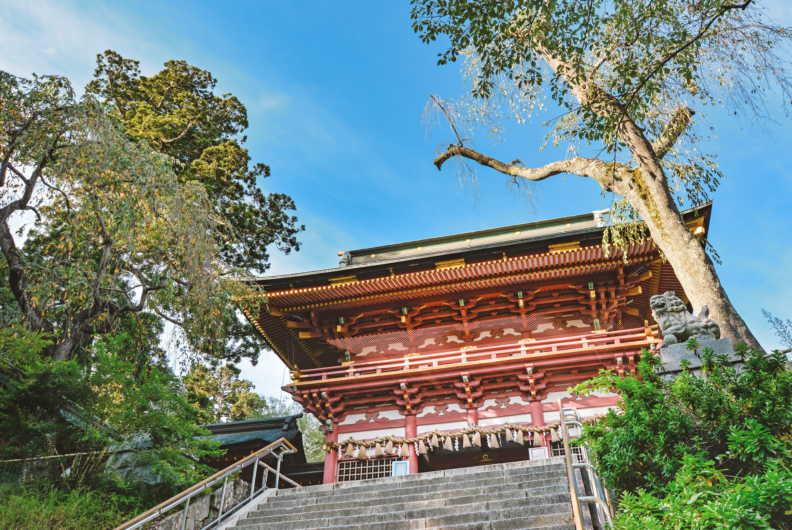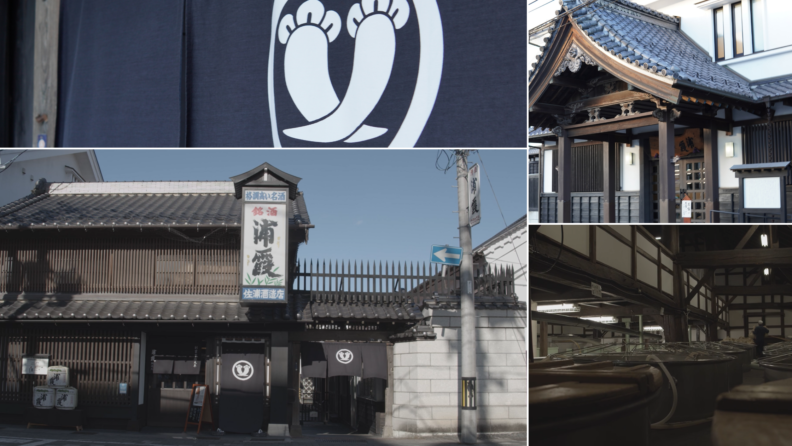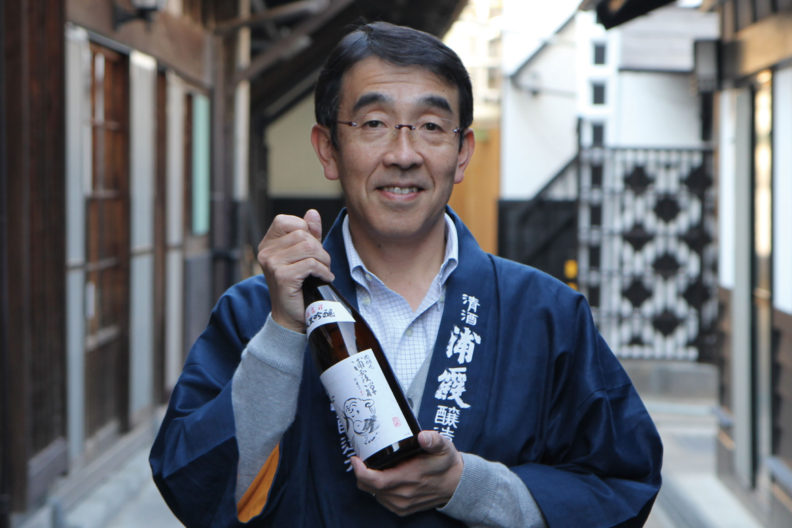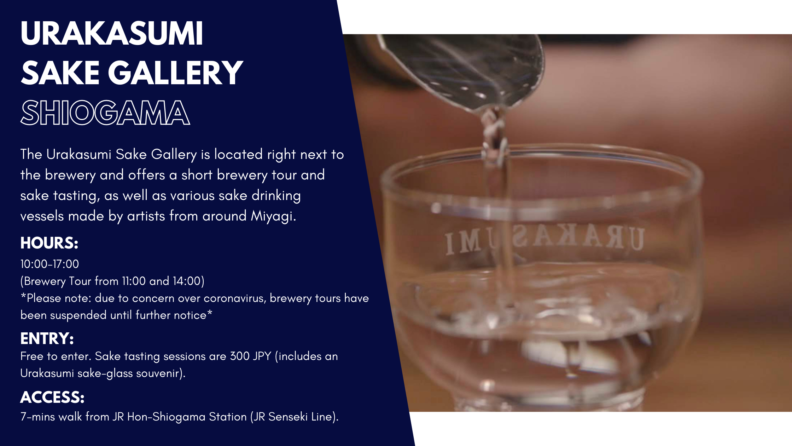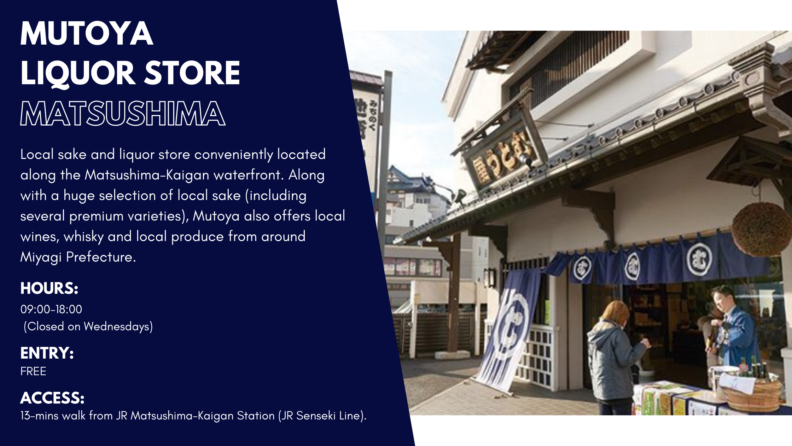Tohoku Local Stories
Tohoku Local Secret Tours Official Blog
Sakagura Campanilismo: Sake Tourism Reimagined
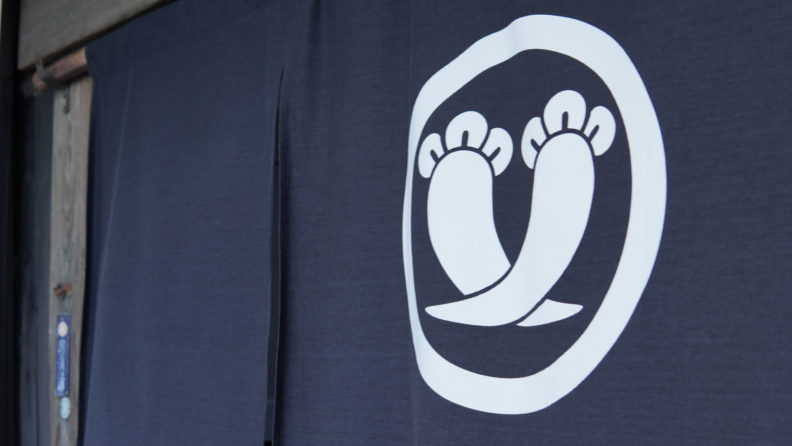

If you’ve ever taken part in a sake brewery tour in Japan, you will likely have learnt that sake is made using four main ingredients: rice, water, ‘koji’ (mould/culture) and yeast. Along with some insight into methods and brewing techniques, this is perhaps enough information for experienced sake-lovers to understand the complexities of different flavour profiles, characteristics and how best to enjoy each variety.
But this is only part of the story!
With over 2000 years of history, there is much more polishing to be done before you reach the metaphorical ‘shinpaku’ (core) of Japanese sake and discover its deep-running connections with the land, culture and people of each local region.
Behind each brewery and label of sake is a story that follows each ingredient from its origins and reveals the ‘storytellers’ – the farmers, brewers, chefs, local people – that come into contact with the sake along its journey from rice-field to ‘masu’ (sake cup). In the same way that the Italian term ‘Campanilismo’ refers to the area within earshot of chimes ringing-out from the local bell-tower (the ‘campanile’), ‘Sakagura Campanilismo’ aims to expand the scope of ‘sake tourism’ outwards from the ‘Sakagura’ (brewery) itself and further into the surrounding region, within the scope of this story.
Below is an exploration of this reimagined concept of sake tourism and the story of Urakasumi Brewery in Shiogama City, Miyagi Prefecture. Through introducing the places, faces, flavours and stories behind three of Urakasumi’s Junmai Ginjo sake varieties (‘Zen’, ‘No.12’ & ‘Sabusawa’) we hope to provide inspiration for a visit to the Shiogama area and a deeper and more meaningful experience of ‘sake tourism’.
Visual concept of ‘Sakagura Campanilismo’ & Urakasumi Sake Brewery in Shiogama City, Miyagi.

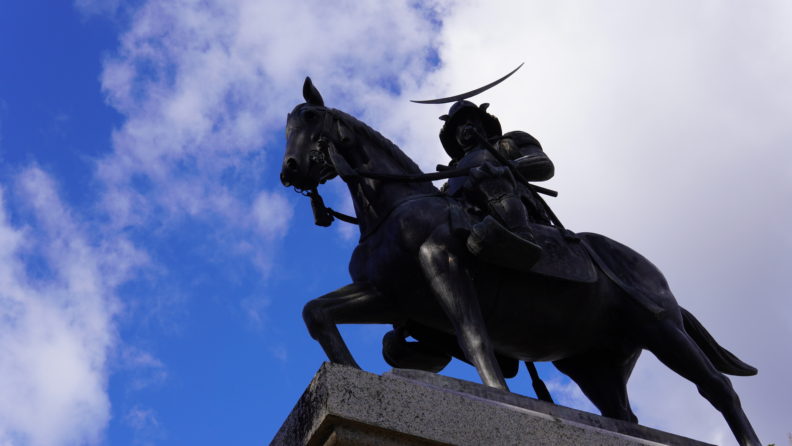
The legacy of ‘Date’ Culture
Even among the hundreds of award-winning breweries dotted throughout the northern Tohoku region, the sake produced in Miyagi Prefecture is held in particularly high regard. Although each of the 25 breweries in Miyagi boasts their own unique techniques and innovations developed over centuries, Miyagi sakes are said to share properties of elegance and clean flavours that pair excellently with the region’s local produce, particularly the delicious, fresh seafood. Over 90% of Miyagi sakes are classified as ‘premium’ sakes and a large proportion (around 55%) are categorised as ‘Junmai’ (sake made with no added alcohol), with the Miyagi Sake Brewers Association proclaiming it to be the flagship style of the prefecture in 1986. Whilst these days Miyagi’s premium sakes are brewed for consumption across Japan and internationally, premium sake production in Miyagi actually holds its roots in the thirst of a fierce samurai…!
Spring water at the former site of Sendai’s first sake brewery in the grounds of Sendai Castle.
Revered as the founder of Sendai City, feudal lord Date Masamune (1567 – 1636) established Sendai Castle in the early 1600s as he expanded the power and influence of the Date Clan through much of what is now Miyagi Prefecture. Along with his tactical prowess on the battlefield, Date was known for his great love of the arts, food and promotion of international exchange and trade, all of which flourished under his rule. Date was said to have frequently enjoyed sake alongside his meals and loved it so much that, when building his castle, he sent for master sake brewer Kayanomori Mataemon of Nara to establish a sake brewery within the castle grounds. The former site of the brewery can still be visited today just behind the Sendai History Museum. A stone’s throw from brewery site is a monument standing at the original water source marking the samurai origins of Miyagi’s sake industry.

Further details of Aoba Castle here.
Moving out of Sendai City and towards the Pacific coast, we arrive at the beautiful Matsushima Bay – one of Japan’s ‘three scenic views’ and the location chosen by the Date Clan for their family temple (Zuiganji Temple) and for entertaining guests. Matsushima Bay is dotted by over 270 pine-clad islands that almost resemble floating bonsai trees. The calm waters between the islands create the perfect environment for cultivating oysters and wakame seaweed.

Whilst the waterfront area of Matsushima Bay is a popular spot for local and international visitors alike, there is much to be explored in and around the bay, including one of the most important port cities located on its shores – Shiogama City. Shiogama is not only a gastronomic heaven famous for landing the largest catch of fresh tuna and other delicious seafood every day, but is also home to the spiritual hub of northern Japan, Shiogama Shrine.
(Shiogama City is accessible via the JR Senseki Line: around 30 mins from JR Sendai Station → JR Hon-Shiogama Station).
Shinto Roots of Miyagi Sake: Shiogama Shrine
For over 1200 years Shiogama Shrine, or ‘Mutsu-no-ichinomiya’, has been the most important shrine in northern Japan. Also favoured by the Date family (there is a history museum in the grounds of the shrine dedicated to the area’s samurai history), Shiogama Shrine remains inextricably linked to the development of sake in Miyagi Prefecture, particularly that of Shiogama’s ‘jizake’ (local sake) produced by Abekan and Urakasumi breweries.
Shiogama Shrine houses three different deities including ‘Shiotsuchi-no-oji’, the god of salt-making. For literally thousands of years the town of Shiogama (塩釜〜literally meaning ‘salt cauldron’) has conducted ‘seaweed salt’ making rituals, and it was believed that it was the God Shiotsuchi-no-oji who first passed on the wisdom of salt-making to the local people. As well as being regarded as general protector of Shiogama, people travel to Shiogama Shrine from all around northern Japan to pray to Shiotsuchi-no-oji for marine safety and safety in childbirth.
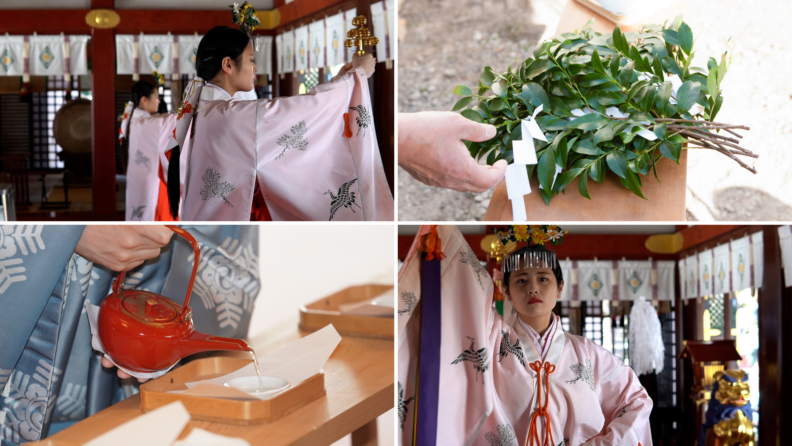
Even before sake filled the cups of feudal lords, it has been a central element of Japan’s indigenous religion of Shintoism. For over 2000 years, sake has been used in Shinto rituals along with salt and water as a method of purification, and the act of sipping on the sake that has been offered to ‘Kamisama’ (Shinto Gods) is a symbolic unification with the realm of the divine.
The sake used in Shinto rituals is referred to as ‘Omiki’ (お神酒)literally meaning sake (酒)of the gods (神).
Ono-negi, the Chief Priest of Shiogama Shrine explains that sake is much more than just a beverage; it has always been ‘a way of bringing our gods and people together’.

Due to the important role that sake plays in Shinto rituals, shrines and sake breweries have always maintained a close relationship. Historically, sake was made by the shrines themselves, but with the regulation of sake production this task was eventually out-sourced to sake breweries – hence why you will often find local sake breweries in close proximity to a shrine. Even today, shrines and breweries have a symbiotic relationship in which the shrines hold rituals to pray to the gods for the prosperity of the brewers and, in turn, the breweries donate barrels of sake for use as ‘Omiki’ in ceremonies and festivals.
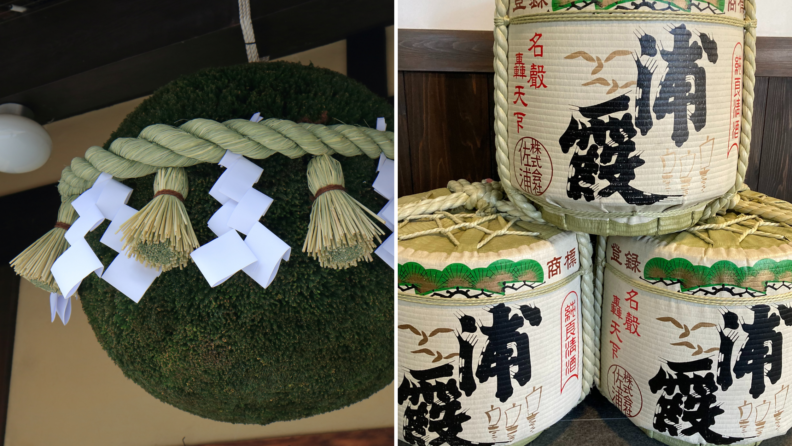
Urakasumi Sake Brewery in Shiogama began its sake brewing operations as provider of ‘Omiki’ to Shiogama Shrine. If you visit the shrine, you are likely to notice the colourful ‘Kodama’ (barrels) of ceremonial sake that has been provided to the shrine by Urakasumi and Abekan breweries. The busiest time for ‘Omiki’ consumption is during the festivals and rituals held at Shiogama Shrine throughout the year.
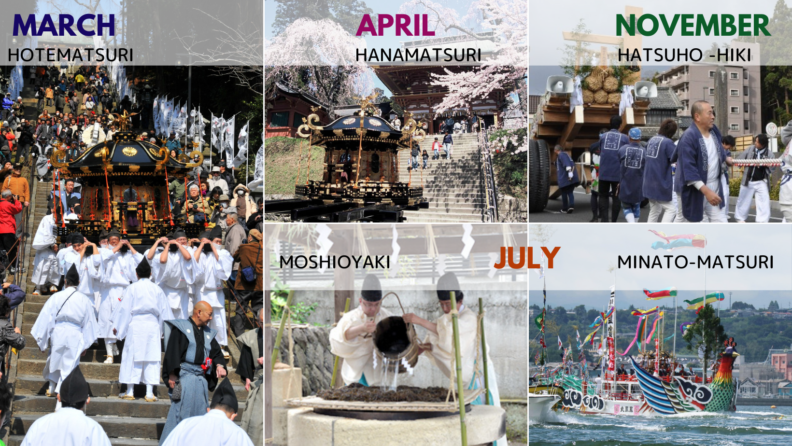
Some of biggest festivals and events on Shiogama Shrine’s calendar.
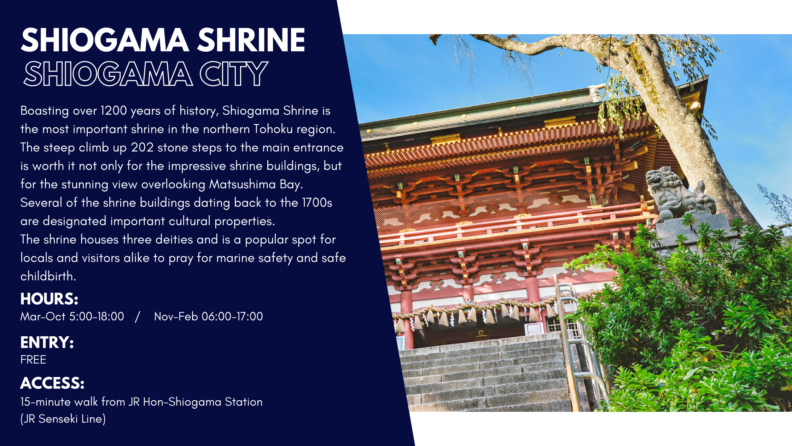
To further explore the Shinto roots of Shiogama’s long history of salt-making, it is recommended to also make a visit to nearby Okama Shrine. Whilst much more subdued than the grandiose buildings of Shiogama Shrine, do not be fooled by appearances! Okama Shrine is no less important – in fact, arguably more important – as it is in this location where Shiogama’s salt-making roots took hold. Like Shiogama Shrine, Okama Shrine also houses the deity of salt-making, ‘Shiotsuchino-oji’, as well as four ancient salt cauldrons that are worshipped as sacred objects. Every year during the ‘Moshio-yaki-gyoji’ salt-making ritual, the sea water that fills these pots is replaced. Mysteriously, it is said that this water – whilst open to the elements – never evaporates nor overflows! Furthermore, any change to the colour of the water is said to warn of impending disaster or a significant event. There are records dating back to the Edo Period that warn to immediately inform the Date lords should any change in the water be observed. Indeed, the day before the Great East Japan Earthquake in 2011, the chief priest of Okama Shrine noted the water had changed from its usual rusty-orange hue to transparent…!
Okama Shrine and its cauldrons have been named one of the three ‘Great Miracles of Japan’.
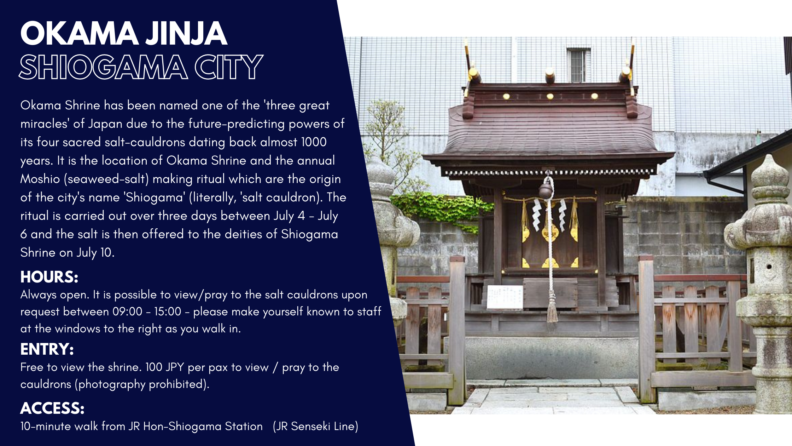

塩竈の浦の松風霞無なり
八十島かけて春や立つらむ
“A breeze blowing over Shiogama bay is so gentle that it is almost like a mist floating in the air.
This dreamy and comfortable atmosphere seems to show the arrival of the long waited spring on the surrounding islands.”
This poem expressing the joy of the arrival of spring in Shiogama is the inspiration for the name ‘Urakasumi’ (浦霞)which literally means ‘Misty Bay’.
Since 1724 Urakasumi Sake Brewery, Saura Co. Ltd. has been producing the ceremonial sake for Shiogama Shrine alongside a variety of ‘classic and elegant’ sakes that perfectly complement the fresh seafood for which Shiogama, as one of the most important fishing ports in northern Japan, is so well renown. Regionality is a high priority for the brewery, which primarily uses sake rice produced locally in Miyagi prefecture to ensure each drop is well matched to local flavours, especially tuna and oysters. Urakasumi sakes are typically characterised by a good umami (savoury richness) of rice, well-balanced flavour and aroma, and a mild, elegant mouth-feel. Maintaining tradition in their method, the consistent high-quality of Urakasumi sake is testament to the brewery’s commitment to produce ‘a genuine sake brewed meticulously, delivered with professionalism.’
Over the span of thirteen generations, Urakasumi has grown from local brewery to a globally recognisable brand, not only hugely influential in the development of Miyagi Prefecture’s sake production, but the direction of Japan’s entire sake industry; particularly in the incredible contribution of current brewery president, Koichi Saura, to the promotion of Japanese sake overseas. Koichi Saura has not only served the industry as the vice chairman of the Japan Sake and Shochu Maker Association but has been integral in the internationalisation of the sake industry through the establishment of the ‘Sake Samurai’ sake ambassador project, as well as the creation of the sake category at the annual International Wine Challenge (IWC) since 2007.
Thirteenth generation president of Urakasumi Sake Brewery, Mr. Koichi Saura.
Providing more than just delicious sake to the local community, throughout the years Urakasumi has been a source of great support, strength and unification for Shiogama and Miyagi through times of hardship and disaster. Just as the call of the bell from the ‘campanile’ of Italian villages is a symbol of regional identity, Urakasumi and the Saura family have been an ever-present connecting force throughout the past three centuries.
Journeying outwards from the brewery and further into the surrounding region – to the places, faces and flavours behind each label – is the best way to fully appreciate the omnipresence of Urakasumi and how each sake variety expresses the particularities of Miyagi’s rich regional ‘terroir’.
Read on to embark on a journey of the wider Shiogama area by following the story of three of Urakasumi’s popular Junmai Ginjo labels:
| URAKASUMI ‘ZEN’ | URAKASUMI ‘NO. 12’ | URAKASUMI ‘SABUSAWA’ |
 |
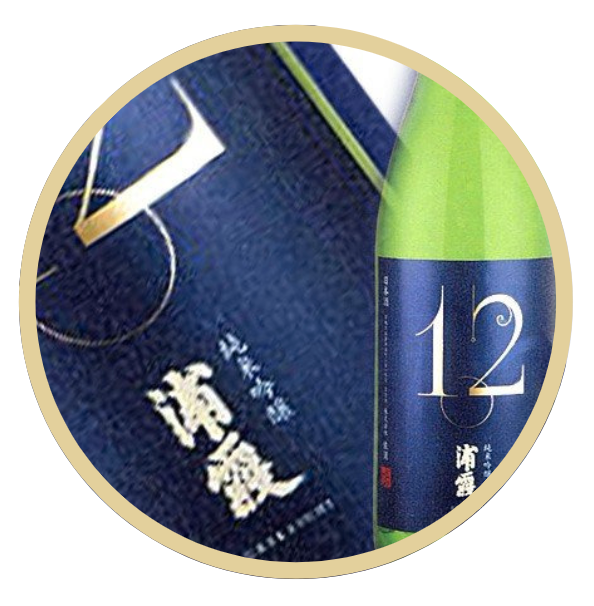 |
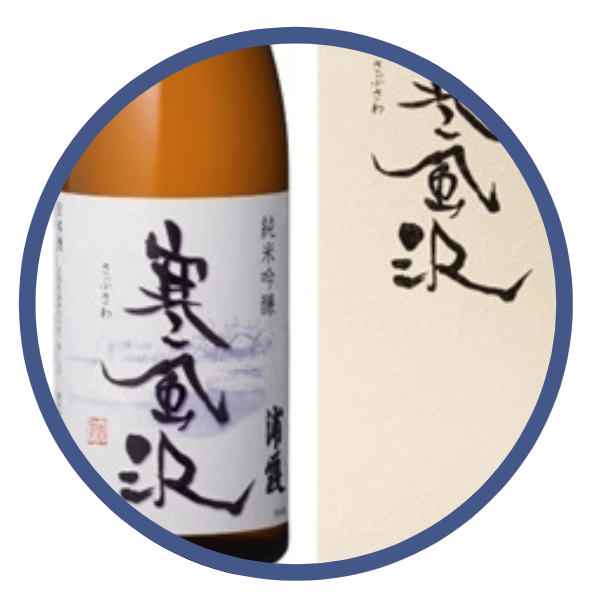 |
Please click on each label to follow the story…!

There are plenty of great accommodation facilities in the Shiogama / Matsushima area offering visitors the chance to sample the delicious local cuisine while soaking up stunning views over Matsushima Bay (whilst sipping on some Urakasumi sake, of course!). Here are some of our recommendations:
MATSUSHIMAHOTEL TAIKANSO |
|
A beautiful hotel featuring panoramic views over Matsushima Bay from a Japanese/Western fusion rooms and natural hotspring baths.
Meals are buffet style with an indulgent selection of dishes made with locally sourced ingredients.
Access: less than 10 mins drive from JR Matsushima-Kaigan Station on the JR Senseki Line.
SENDAITHE WESTIN SENDAI |
|
Located in the heart of downtown Sendai City, The Westin Sendai offers both incredible convenience, impeccable hospitality and understated luxury. Panoramic views over Sendai City, the surrounded mountains and Pacific Coast can be viewed from the building’s upper floors. Guests can choose from the comforts of 4-star grade rooms or club-level rooms and suites.
Access: 5 mins drive from JR Sendai Station.

Can’t get enough local sake? Be sure to drop by one of the below locations to stock-up on your favourite drops so you can continue the journey at home! Ask the friendly store owners for their recommendations, including some limited edition brands that can only be purchased in the Shiogama / Matsushima area!

CLICK HERE FOR COMPANY DETAILS
Private driver-guide services also available!

